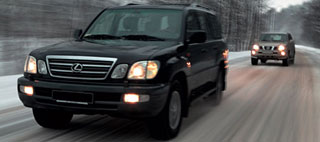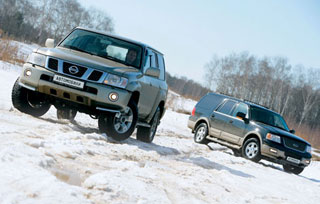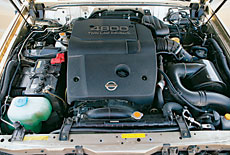Nissan Patrol LWB test drive since 2004 SUV
Secret in "pots"
The most powerful Nissan Patrol came to RussiaThe great -grandmother pamper me with Russian cuisine: then the dumplings will make such that at a time you eat fifty, then he will weld the bruise that you recognize it by aroma from distant approaches to the house. And hot?! How many my relatives on the female line did not try to repeat this miracle of cooking, and they could not. And the grandmother said: the whole thing in pots really, ceramic pots were handmade and very old, so that in several decades they managed to soak in taste. I vividly remembered these grandmother's words as soon as I was driving the flagship Nissan Patrol, equipped with a 4.8-liter gasoline engine. Its highlight is that such a huge volume of Japanese engineers spilled only six pots of cylinders. So this motor is simply amazing. And I did not want to leave the SUV how to get up from the grandmother's table
Look at the speedometer
 We left a colleague from the Russian representative office of Nissan, and he tells me they say, no further than in September last year, he was already riding a diesel Patrol in the environs of the Etna volcano (AI No. 18 (63), 2004). So he stopped and crossed me behind the wheel.
We left a colleague from the Russian representative office of Nissan, and he tells me they say, no further than in September last year, he was already riding a diesel Patrol in the environs of the Etna volcano (AI No. 18 (63), 2004). So he stopped and crossed me behind the wheel. Having settled down comfortably on the throne (otherwise a huge front chair, sheathed with skin and equipped with all conceivable adjustments, excluding the ventilation, you can’t call it), adjusting the steering wheel and pedal unit with electric drives, I started off, pressing the accelerator pedal stronger to the floor. Patrol began to accelerate. Not so briskly, I hastened to say. Look at the speedometer calmly, a colleague answered. Mother of God! So we have already scored 120 km/h, and the sensations are such that we are practically standing.
Here it is, the peculiarity of large cars, regardless of the type of body, they conceal the sensation of speed. Moreover, I note, an SUV equipped with unreasonable beams-bridges on both axles (such a layout can be called anti-Asfall, since the suspension is completely dependent), behaved very decent, did not show any hint of screening. I recalled the Saza’s phrase from a press release, which read that this car was equipped with a disconnected stabilizer of the transverse stability. At first, it seemed to me that this is another electronic bush that does not add anything except the additional cost. Then I could not even think that this thing really works. On off -road, it is disconnected by a separate button and allows the wheels to walk within an arch with huge amplitudes. But as soon as it comes to asphalt, and the speed increases to 20 km/h, Patrol automatically activates this option. The stabilizer does not allow the body to swing on gentle waves, thereby extinguishing unnecessary lateral forces and increasing the terminal stability. A convenient thing, you can’t say anything.
The main thing is traction
 But I will still return to wonderful pots. Their charm lies in the huge volume of each by 800 cubic meters. See this technical solution provides not so much an increase in engine power as traction capabilities. And for acceleration, it is precisely this parameter that is responsible (horsepower are important to achieve high maximum speed). So, Nissan Patrol does this exercise up to 100 km/h in just 10.8 seconds, which is a great result for a heavy SUV. At the same time, I remind you that we are talking about a purebred jeep of a frame structure, with blocks and weighing almost 2.5 tons. Few in the modern automobile world have preserved such models in their range. And even more so in such a luxurious performance (the latest generation Range Rover does not count this car of a slightly different, bohemian format). So, in our case, Patrol flashed with light cream upholstery of the seats, wood inserts, a radio with a built-in subwoofer and a scattering of speakers along the cabin, climate control, electric hatch, etc.
But I will still return to wonderful pots. Their charm lies in the huge volume of each by 800 cubic meters. See this technical solution provides not so much an increase in engine power as traction capabilities. And for acceleration, it is precisely this parameter that is responsible (horsepower are important to achieve high maximum speed). So, Nissan Patrol does this exercise up to 100 km/h in just 10.8 seconds, which is a great result for a heavy SUV. At the same time, I remind you that we are talking about a purebred jeep of a frame structure, with blocks and weighing almost 2.5 tons. Few in the modern automobile world have preserved such models in their range. And even more so in such a luxurious performance (the latest generation Range Rover does not count this car of a slightly different, bohemian format). So, in our case, Patrol flashed with light cream upholstery of the seats, wood inserts, a radio with a built-in subwoofer and a scattering of speakers along the cabin, climate control, electric hatch, etc. The transfer of all equipment in the cabin can take more than one newspaper strip. The main thing, in my opinion, is an all-wheel drive transmission, which is equipped with a 5-speed automatic with the possibility of manual selection of the range. I remember that my colleague after the pan -European test was not enthusiastic about the Patrol version with the automatic transmission, but then he got cars with an old box. At my order, there was a modern unit, which reacted to the commands instantly, without delay, switching to increased or reduced gear. In general, he put the selector into Drive mode, and forgot that something else should be pulled. The manual regime, frankly, was really needed only once, when it was necessary to go down from a steep hill, where we climbed for a beautiful look. Nissan did not develop a special program for descent from the mountains, as many of its competitors did, and offers simply to force the first gear and remove the leg from the gas pedal. Then the car will slowly and reliably go down from any elevation, no matter how cool its slopes would not be. The main thing is not to forget to activate the entire transmission potential by connecting all -wheel drive (in the road conditions Patrol is a rear -wheel drive car), coupled with a reduced transmission and locking of the rear and center differentials. Then the SUV on any coating, even on slippery snow, as in our case, will obey the helm and go to where his driver directs, and not the power of attraction.
It is noteworthy that for the first time in my life I used cruise control not for the highway, but for impassability. A huge torque of the motor, and this is 400 Nm, outside the roads, does not provide the best service to the driver. A light touch of the gas pedal causes some jerk forward, which in a certain situation may be fatal in terms of cross -country ability. Cruise control completely eliminates this. You just activate it with buttons on the steering wheel and select the speed. Say, 10 km/h, then release the brake pedal, and the car itself, very smoothly accelerates. This decision seemed to me very successful.
What else shows the advantage of a powerful engine is in complete indifference to the loads on it. Seven people can be seated in Patrol, and he will go as if in the car, except for the driver, and there is no one. It seems to me that a trailer weighing up to 3500 kg will not spoil the temperament, even if a decent boat will shine on it. By the way, it is for such needs in our country that they most often acquire a powerful SUV. In order to quickly get to the water, while not once thinking about whether the car can go down to the shore and move its rear wheels into the water (most trailers for transporting boats can only be unloaded in this way). I am glad that the designers know about such a purpose of the car and, apparently, therefore, the exhaust pipe is located as high as possible.
Eating is sometimes not harmful
Finally about prices. Each of the pots of a powerful 4.8-liter engine will cost a little more than $ 10,000. In other words, the flagship Patrol costs $ 63,500. At the same time, a 3-year-old factory warranty is provided for a car, and some dealers for moderate money offer to extend it for a year or two . Very good conditions, I must say. All this has only one grief of fuel consumption. The manufacturer claims that in a mixed cycle, the SUV consumes 18.2 liters of 95th gasoline per 100 km of path. I dare to argue that in the Moscow conditions, in addition in winter, about five more liters should be thrown. However, if I were a potential buyer of this car, I would not frighten me such an appetite, as I did not scare the stomach in childhood, which has swollen from excessive absorption by my grandmother's cooking
Sergey Ilyinsky
Brief technical characteristics Nissan Patrol 4.8
Engine volume, cubic meter. See 4759
The number of valves per cylinder 4
Power, l. With. at about./min. 245/4800
Max. Torque, Nm/at about. min. 400/3600
Acceleration to 100 km/h, p. 10.8
Maximum speed, km/h 190
The average fuel consumption l./100 km. 18.2
The volume of the fuel tank, l. 95
Car mass, kg 2460
Dimensions, mm. 5145x1940x1855





